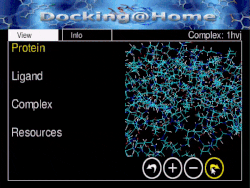Docking@Home
 | |
| Developer(s) | University of Delaware |
|---|---|
| Operating system | Linux, macOS, and Windows[1] |
| Platform | BOINC |
| Website | docking |
Docking@Home was a volunteer computing project hosted by the University of Delaware and running on the Berkeley Open Infrastructure for Network Computing (BOINC) software platform. It models protein-ligand docking using the CHARMM program. Volunteer computing allows an extensive search of protein-ligand docking conformations and selection of near-native ligand conformations are achieved by using ligand based hierarchical clustering.[2] The ultimate aim was the development of new pharmaceutical drugs.
The project was retired on May 23, 2014.[1]
See also
References
- ^ a b "Docking@Home is Retiring". Archived from the original on 2014-10-17. Retrieved 2014-06-15.
- ^ Estrada, Trlce; Armen, Roger; Taufer, Michela (2010-08-02). "Automatic selection of near-native protein-ligand conformations using a hierarchical clustering and volunteer computing". Proceedings of the First ACM International Conference on Bioinformatics and Computational Biology. BCB '10. New York, NY, USA: Association for Computing Machinery. pp. 204–213. doi:10.1145/1854776.1854807. ISBN 978-1-4503-0438-2. S2CID 6040735.
Further reading
- "Computer Idle? Now You Can Donate Its Time to Find a Cure for Major Diseases". Newswise. June 16, 2009. Retrieved 2009-07-27.
External links
- Official website

- Docking@Home screensaver video on YouTube

- v
- t
- e
- Amicable Numbers
- Asteroids@home
- climateprediction.net
- Collatz Conjecture
- Cosmology@Home
- DENIS@home
- Einstein@Home
- Gerasim@home
- GPUGRID.net
- iThena
- LHC@home
- LODA
- MilkyWay@home
- Minecraft@home
- MindModeling@Home
- Moo! Wrapper
- NFS@Home
- NumberFields@home
- ODLK
- ODLK1
- PrimeGrid
- QuChemPedIA@home
- RakeSearch
- Ramanujan Machine
- Rosetta@home
- SIDock@home
- SRBase
- Universe@Home
- World Community Grid (subprojects Clean Energy Project, Discovering Dengue Drugs – Together, FightAIDS@Home, Fiocruz Genome Comparison Project, Help Defeat Cancer, Help Conquer Cancer, Help Cure Muscular Dystrophy, Human Proteome Folding Project, Help Fight Childhood Cancer, Smash Childhood Cancer)
- WUProp@Home
- yoyo@home
- RNA World (beta)
- TN-Grid
- WEP-M+2 Project
- nanoHUB@home
- RADIOACTIVE@HOME
- YAFU
tools
or inactive
- ABC@Home
- AQUA@home
- Artificial Intelligence System
- BBC Climate Change Experiment
- Big and Ugly Rendering Project
- CAS@home
- Cell Computing
- Citizen Science Grid
- Correlizer
- DistrRTgen
- Docking@Home
- EDGeS@Home
- Enigma@Home
- eOn
- Evolution@Home (yoyo@home subproject)
- FreeHAL
- HashClash
- Ibercivis
- Kryptos@Home
- The Lattice Project
- Leiden Classical
- uFluids@Home
- Malaria Control Project
- MLC@Home
- OProject@Home
- orbit@home
- POEM@Home
- Pirates@Home
- Predictor@home
- proteins@home
- RALPH@home
- Riesel Sieve (merged with PrimeGrid)
- QMC@Home
- SAT@home
- Seasonal Attribution Project
- SETI@home (subproject Astropulse)
- SETI@home beta
- SIMAP
- SLinCA@Home
- Spinhenge@home
- SZTAKI Desktop Grid
- TANPAKU
- theSkyNet
- VGTU@Home
- XtremLab
 | This computer science article is a stub. You can help Wikipedia by expanding it. |
- v
- t
- e
 | This computer networking article is a stub. You can help Wikipedia by expanding it. |
- v
- t
- e











